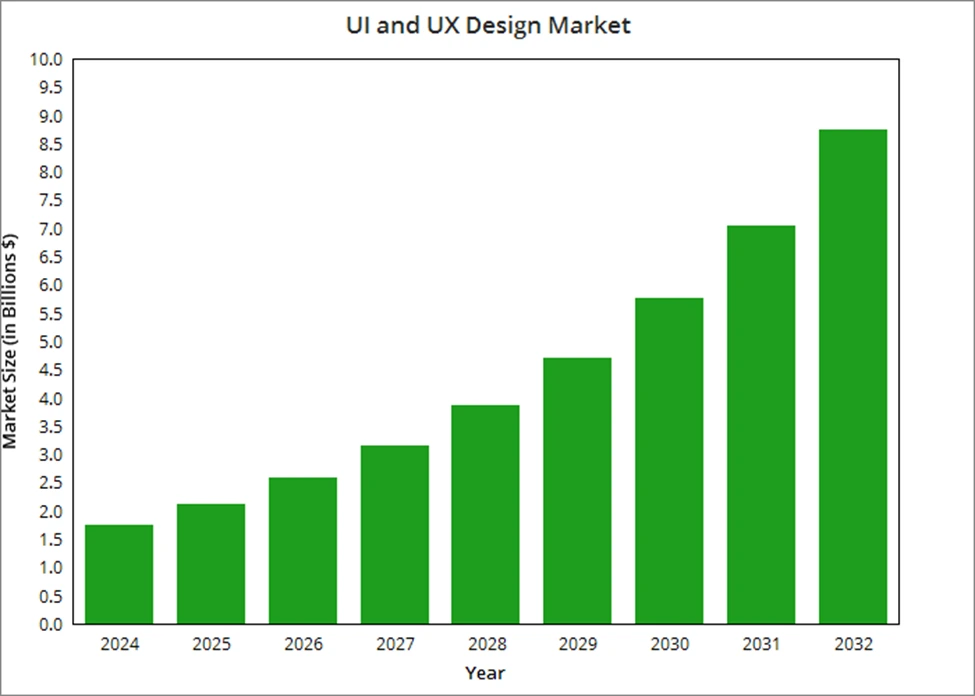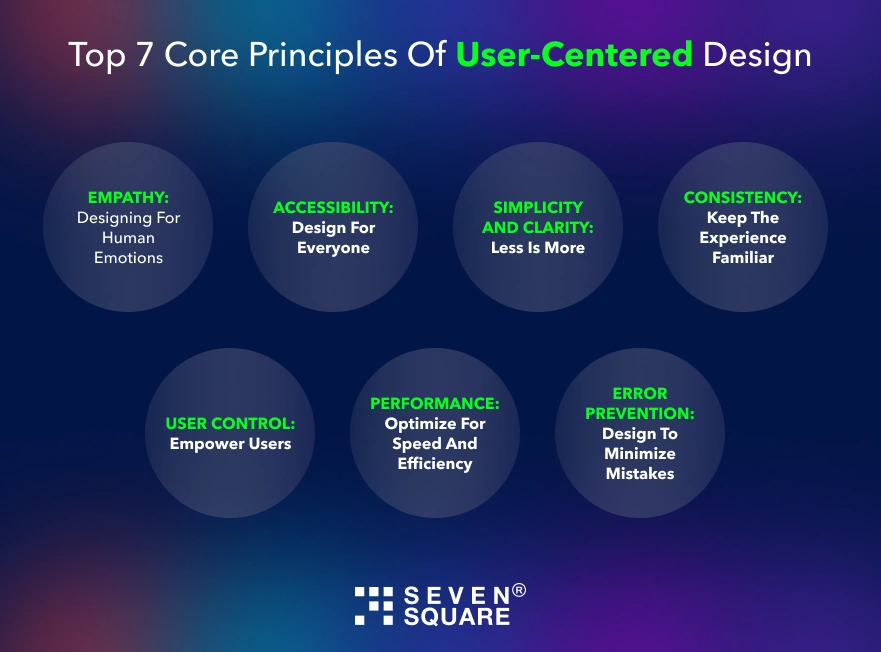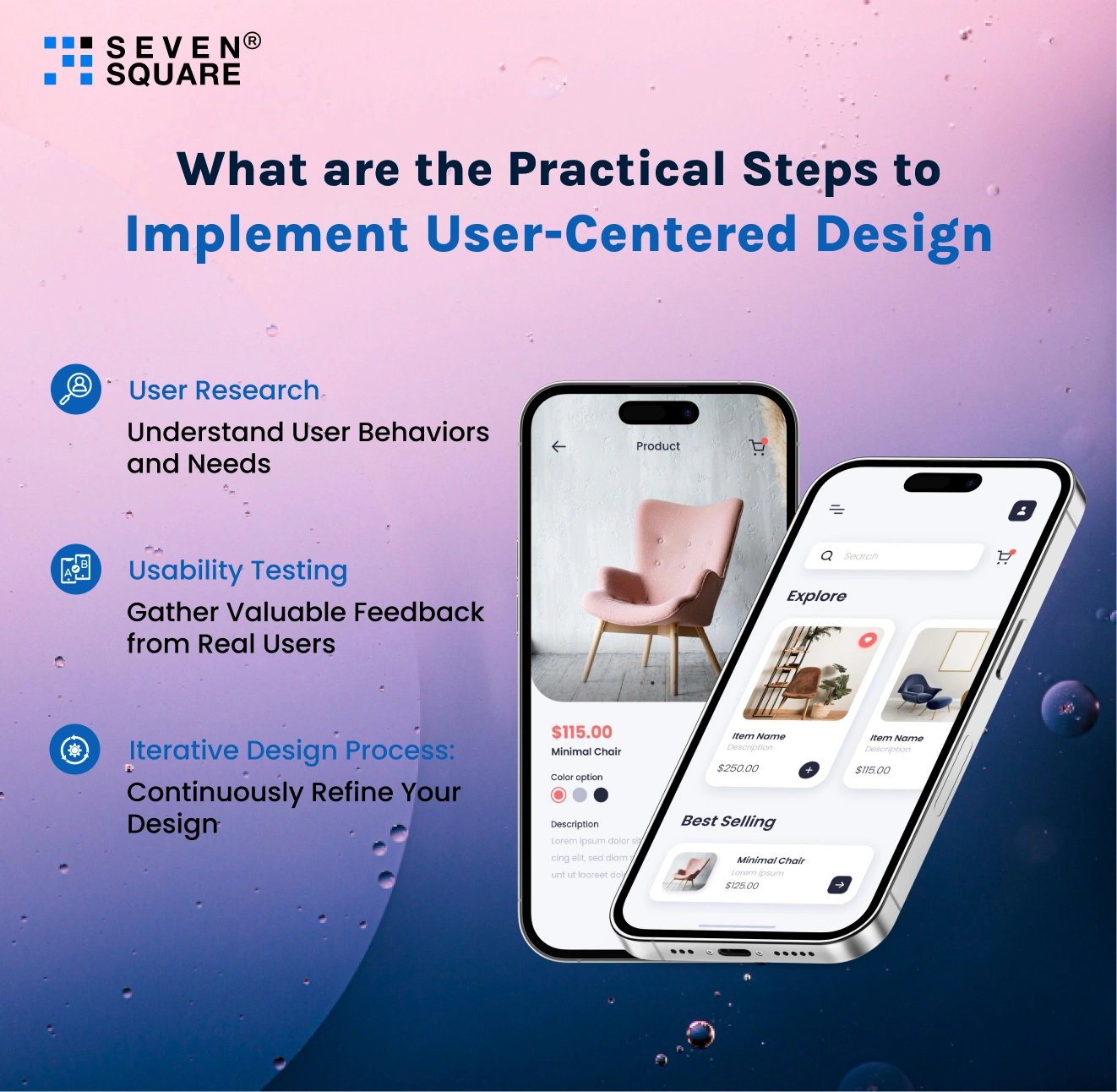User experience design principles are the backbone of successful products. Whether you’re designing an app, a website, or any digital platform focusing on your users is key.
Why? Because when users have a smooth, dynamic, and enjoyable experience, they’re not only satisfied, but they also become loyal to your brand.
In this blog, you can understand the Top 7 Fundamental User Experience Design Principles that every business must follow to create user-centered designs.
From reducing friction to building trust, these principles ensure your design connects with users and keeps them returning for more.
So, if you want to improve your design game and boost user satisfaction then stay with us to understand how to create a user-centered design.
What is User-Centered Design?
At its core, User-Centered Design (UCD) is an approach that puts real users at the center of the design process. Instead of guessing what users want, businesses do proper research, testing, and feedback loops to understand actual user behaviors, pain points, and preferences.
Think about it: If your design solves a user’s problem and makes their experience enjoyable, they’re more likely to use it again.
A successful design isn’t just about aesthetics; it’s about creating an experience that meets user expectations.
The UI/UX design software market is growing at a CAGR rate of 22.25% and is expected to reach $8.75 billion by the end of 2032.

Why Focusing on Users is Key to Great Designs?
Nowadays, focusing on user experience design principles is not only necessary but it’s essential. Whether you’re creating an app, website, or any digital product, the user’s needs and preferences must be at the forefront of your design decisions.
Let’s understand why user-centered design matters and how it impacts both the user and your business:
1. Improving User Satisfaction :
- Why it’s important : When you prioritize user needs, you make their journey smoother and more enjoyable. Satisfied users are more likely to engage with your product, explore its features, and come back for more.
- How it works : Imagine using an app that’s easy to navigate with clear instructions and intuitive design. When users feel that the design “gets them,” their satisfaction skyrockets.
2. Building Trust and Loyalty :
- Why it’s important : Users are more likely to trust brands that make them feel understood. When your design aligns with their needs and expectations, you create positive associations that build long-term loyalty.
- How it works : Take Apple as an example. Their focus is on user-centered design, where each element is created to make the customer’s life easy which increases brand loyalty. People trust Apple to deliver a flawless and reliable experience.
3. Reducing Friction :
- Why it’s important : Friction in design, whether it’s a confusing layout or a slow load time creates frustration. When your design is dynamic and matches with the users’ behavior you eliminate this friction to make the user experience smooth and efficient.
- How it works : Think of Spotify. The app’s design allows users to easily discover new music, create playlists, and stream their favorites quickly. This smooth experience keeps users coming back and exploring more features.
4. Real-Life Example: Higher Engagement Through User Focus :
- Slack’s User-Centered Design : Slack is one of the most popular messaging platforms which was designed with user needs in mind.
- By creating an intuitive interface with features like easy file sharing, notifications, and seamless integration with other tools, Slack drastically improved team communication.
- The takeaway : When designs revolve around what users want and how they behave, businesses see higher engagement, greater retention, and a stronger connection with their audience.
Top 7 Core Principles of User-Centered Design

Designing for users isn’t just about making things look good but it’s about understanding who your users are and how they interact with your product. The best designs come from a deep focus on user needs, behaviors, and emotions.
Let’s explore the core user experience design principles that help to create experiences users love:
1. Empathy: Designing for Human Emotions :
- Empathy is the heart of user experience design principles. It means thinking from your user’s perspective and considering their feelings, frustrations, and goals.
- Example : Airbnb redesigned its platform after realizing that travelers often felt disconnected from local experiences.
- Airbnb improved its user satisfaction by focusing on emotional connection and became a leader in the hospitality sector.
2. Accessibility: Design for Everyone :
- A truly user-centered design is accessible to all regardless of abilities or disabilities.
- Always ensure that your design is inclusive means more people can enjoy your product. It is one of the main UX design benefits and principles that you need to focus on.
- You can use alt text for images to ensure keyboard navigability, and follow WCAG (Web Content Accessibility Guidelines) to create a more thorough experience.
3. Simplicity and Clarity: Less is More :
- Users don’t want to be overwhelmed by complex designs. A clean and straightforward interface makes it easier for them to find what they need and accomplish their goals quickly.
- Google’s homepage is the best example of simplicity. With just one search bar, users know exactly what to do. Its minimalist design makes it the most visited website in the world.
- It is one of the best examples of user experience design principles and to scale up your business you need to learn from it.
4. Consistency: Keep the Experience Familiar :
- Consistency across different platforms and touchpoints helps users feel comfortable and confident in using your product.
- Whether they’re on a mobile app or desktop, users should recognize familiar elements like buttons, navigation menus, and icons.
- Wondering how do you use user centered design UX to scale up your business? Then you have to maintain consistent typography, color schemes, and layouts across all platforms to build user trust and comfort.
5. User Control: Empower Users :
- Giving users control over their experience improves satisfaction rates. This can be as simple as providing the ability to undo an action or customize certain aspects of the interface.
- In user-centered design, you can often see the features like “Undo” buttons and customizable settings. Apps like Spotify and Gmail have these features which allow users to control their own experience.
6. Performance: Optimize for Speed and Efficiency :
- Even the most beautifully designed product will fail if it’s too slow or clunky to use. You need to focus on user experience design principles because these can make or break your product.
- Performance optimization ensures that your product loads quickly and functions efficiently.
- One of the best real-life examples of user-centered design is YouTube which optimizes loading times for videos to ensure a smooth and uninterrupted experience for millions of users daily.
7. Error Prevention: Design to Minimize Mistakes :
- Users make mistakes but a well-designed product expects those mistakes and helps prevent them. This creates a smoother and more satisfying user experience.
- One of the best examples of following a user centered design process is integrating the features like autofill forms, smart suggestions, and confirmation prompts to reduce errors.
- Gmail provides an “Undo Send” option that helps users recover from potentially costly mistakes.
The User Experience Design Principles That We Follow While Working on Various Projects
At Seven Square, we understand that creating a great design goes beyond aesthetics. It’s about ensuring that users have a seamless, intuitive, and enjoyable experience.
Let’s understand the user experience design principles that we follow to deliver high-quality UI/UX designs across different projects.
1. Focus on UX (User Experience)
- Why it matters : Great UX design is all about making users’ interactions with a product as easy and pleasant as possible. We start every project by thoroughly understanding the users’ needs, behaviors, and pain points.
- How We Apply It : We conduct user research, create user personas, and map out user journeys to ensure that our designs meet user needs at every step.
- While working on a project called Meditation, we ensured that it had user centered design so every user could easily connect with it.
- In this app, users enjoy meditation techniques in the form of articles, audio, videos, books, and many more.
2. Development Compatibility & End-User Compatibility
- Why it matters : A design that looks great but isn’t compatible with the development platform or the end-user devices won’t handle it.
- Our designers ensure technical compatibility and ease of use across devices and operating systems.
- How we apply it : We follow user experience design principles to ensure that our designs are implementable across various platforms from desktop to mobile without losing quality or functionality.
3. Domain-wise UI (Industry Specific Designs)
- Why it matters : Different industries have different standards and expectations when it comes to user interfaces.
- For example, while building a fintech app we focus on creating a design that shows trust and security while a media app needs a creative and engaging layout.
- How we apply it : We customize user centered designs according to the specific domain of the client’s business, industry norms, and user expectations.
- By understanding the industry, we deliver designs that resonate with the target audience.
- Recently while working on a project about the healthcare industry we followed these user experience design principles to ensure that the website is user-friendly.
- Our designers integrated some of the best animations and images on this website according to the client’s requirements.
- The project is all about an institute that specializes in biostatistics training for statisticians and clinical persons.
4. Focus on Fonts
- Why it matters : The choice of fonts plays a huge role in the readability and overall aesthetic of the design. Poor font choices can hurt user engagement and lead to frustration.
- How we apply it : We believe that fonts are one of the key factors in UX design principles as fonts not only create a brand’s unique identity but also ensure readability across all screen sizes.
- While going through a user centered design process we also use some of the top Figma alternatives so that clients can get the best UI/UX designs for their projects.
5. Color Combinations: Creating Emotional Impact
- Why it matters : Colors have a powerful emotional impact on users which can influence their perception of a brand and even their decision-making.
- Our designers always choose the right color scheme that can build trust, and create a calming atmosphere.
- How we apply it : We carefully choose color combinations that align with the client’s brand identity and get the right emotional response from users.
- Whether it’s the calm blue for fintech apps or the energetic red for a media brand we ensure that color choices improve the overall user experience.
What are the Practical Steps to Implement User-Centered Design?

Creating user-centered design is not just about perception but it requires a clear process that puts users at the heart of every decision.
Let’s look at the practical steps to implement user experience design principles that will keep users engaged and improve overall satisfaction.
1. User Research: Understand User Behaviors and Needs
- Conduct interviews, surveys, or focus groups to get a deep understanding of your users.
- Create user personas based on the research to guide design decisions.
- Map out user journeys to visualize how users will interact with your product.
Tip for designers : Prioritize empathy. Always design with the user’s experience in mind. Ask, “What does the user really need from this product or feature?”
2. Usability Testing: Gather Valuable Feedback from Real Users
- Test early and test often—this can be done with wireframes, prototypes, or beta versions.
- Observe how real users interact with the design and take note of any struggles or confusion.
- Gather feedback, both qualitative and quantitative, to guide the next iteration.
Tip for businesses : Make usability testing a part of your design process from the start. Small, regular tests can catch problems early and prevent expensive redesigns down the line.
3. Iterative Design Process: Continuously Refine Your Design
- After each usability test or feedback session, make incremental improvements to the design.
- Focus on solving user pain points that emerged during testing.
- Keep refining the design until it meets user expectations and business goals.
Tip for designers : Don’t be afraid to change. If the feedback suggests that something isn’t working, take it as an opportunity to enhance the design, even if it means making significant changes.
Do you want to get the best UI/UX design for your project? Contact Us Now!
FAQs
By following the user experience design principles mentioned in this blog businesses can create interfaces that are easy to use, aesthetically pleasing, and functional. It means that you can provide a more enjoyable experience to improve user satisfaction.
Businesses can implement user-centered design by:
- Conducting thorough user research.
- Testing prototypes with real users.
- Adopting an iterative design process.
- Prioritizing accessibility and simplicity in their designs.
- Yes, User-Centered Design can help to reduce costs by identifying and addressing usability issues early in the development process.
- This approach prevents costly redesigns and fixes after launch to save a lot of time & resources in the long run.
- Traditional design approaches often focus on aesthetics and functionality from a business perspective.
- User-Centered Design prioritizes the user’s experience ensuring that the design is intuitive, accessible, and meets real user needs.
- By improving usability and minimizing friction the user experience design principles can improve conversion rates.
- A well-designed and user-friendly interface motivates users to complete desired actions like making a purchase or signing up for a service.
- The mobile-first design ensures that the user experience is optimized for mobile devices.
- It is because mobile traffic accounts for more than 50% of global web traffic and prioritizing mobile design means better user engagement for a smooth experience across all devices.